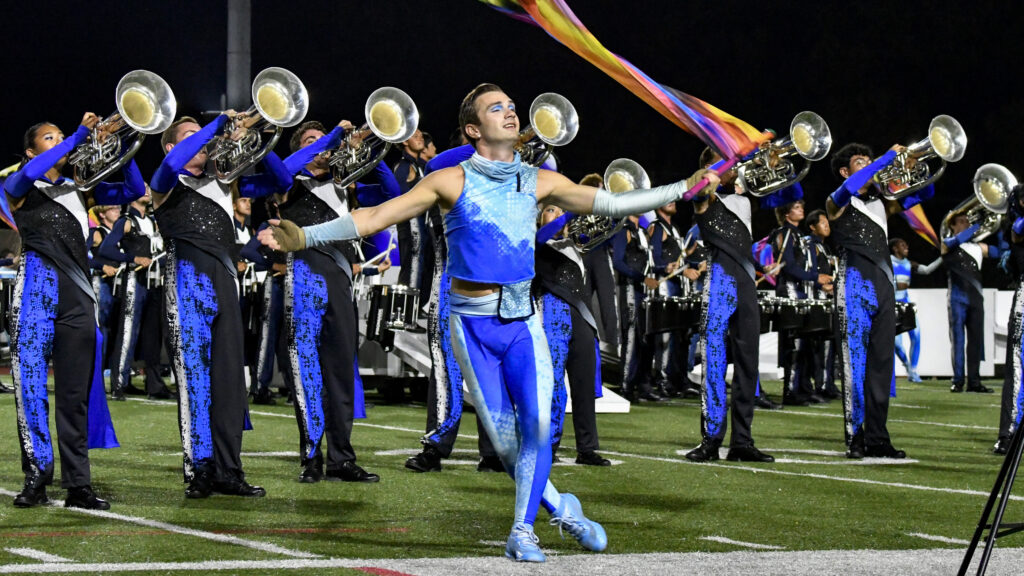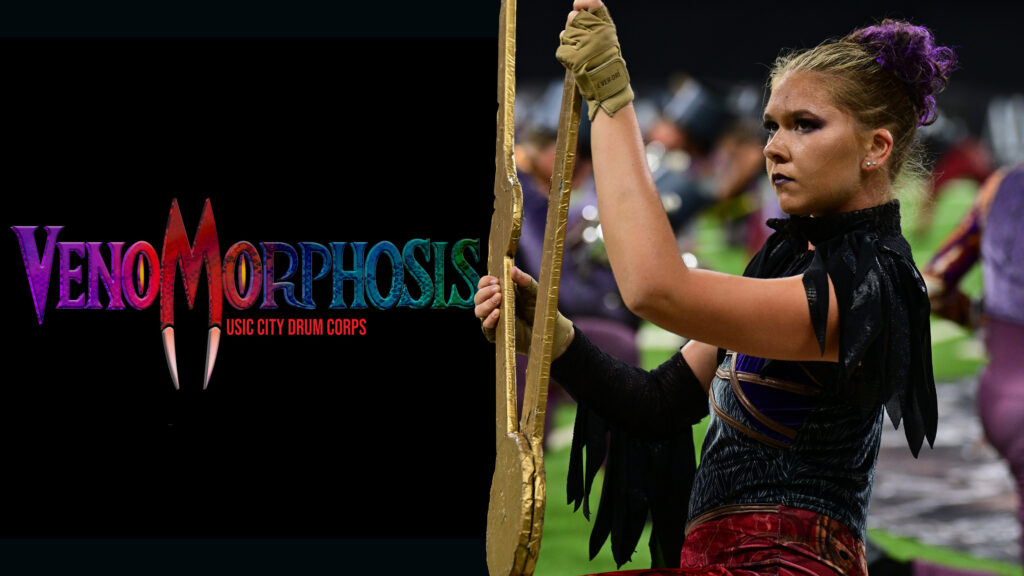Throughout the 2010s — a decade featuring widespread evolution in show design — you could point to numerous moments of pivotal change for the Bluecoats.
But there’s no denying one specific fact. The Canton corps never looked the same after 2012.
It may have been coincidence — or, maybe it wasn’t — but the corps’ program that summer, “Unmasqued,” which ended with performers removing masquerade-style face coverings, also marked the final use the of Bluecoats’ recognizable royal-blue-paneled uniforms.
It was only a matter of time, from there, that darker, arguably sleeker shades of blue would give way to a new era of uniform design in northeast Ohio.
By 2012, Bluecoats, a corps that had been around since DCI’s inaugural year of 1972, had finally tasted the excitement of a top-three finish. Just two years removed from a bronze medal, they were squarely on people’s radars. 2012 wasn’t the competitive showing many other years in the 2010s ended up being — once Bluecoats took home a silver medal in 2014, they reached a new competitive stratus for the years that followed — but it was memorable nonetheless.
In short, 2012 was the continued unmasking of several characteristics — some noticeable, others subtle — that have become synonymous with Bluecoats to this day.


2012 Bluecoats — “Unmasqued”
6th Place, 92.550
Alluded to in the unique spelling of its title, “Unmasqued” was a show centered musically around the motif of Andrew Lloyd Webber’s “Masquerade” from “The Phantom of the Opera,” its first notes featured the foundational song’s melody, as it sounded from a music box at a key juncture in the hit 1988 musical.
Each performer, across all sections, opened the show wearing the kind of mask one might see at a masquerade ball. Featuring “Filet,” written by Benoit Jutras for the 2005 film “Le Rêve,” musical tones darkened as corps made its way closer to the front-and-center of the field.
Before long the “Masquerade” melody was back, in full force as the corps’ opening impact, with the horn line standing in the shape of a mask. After a strong and positive opening passage, the happy tones of Lloyd Webber’s melody darkened once again into a minor chord, which gave way to the show’s percussion-heavy second movement.
The moments that followed were, largely, based once again on Jutras’ “Filet,” with shades of “Masquerade” continuing to permeate. The mix of the two created a second movement that was far more in-your-face than that which came before it, rife with high brass features, groove sections, and moments of color guard prowess from a unit that was dressed head-to-toe in black, white and light purple, with a sort of Victorian flair.
The emotion of Bluecoats’ 2012 production came to life in the third movement, which was based upon “Flume,” an introspective and solemn song written and popularized by American indie folk band Bon Iver. The song worked well as the emotional centerpiece of “Unmasqued;” it made it clear that the program was far deeper than commentary on clothing and accessories. Rather it featured a theme of one’s ability to feel hidden, guarded or closed off from those around them.
As a lyrical baritone soloist presented the song’s main melody, voiced words like “alone,” “empty,” “fragile,” and “afraid” echoed from the front ensemble percussion section, painting a clear-cut image of the emotions at play in this chapter of the story being told on the field. During this movement, various members of the color guard removed their masks.
According to Bluecoats drum major Dave Schaefer, performing members of the corps had a hand in the design of this particular section of the program.
“All of the words that you hear are words from the members of the corps,” he said. “During [spring training rehearsals], they set a box out by the food truck, and they said to write down a word — don’t show it to anybody else, but make it personal, and make it something about yourself that you don’t like people to see.”
“The mask is covering some aspect of ourselves that we don’t necessarily like,” Schaefer added. “Something that we don’t want people to see. The garment represents the word or the imperfection in yourself.”
If “Unmasqued” did one thing, it kept viewers on their toes, covering the gamut of the ups and downs of personal emotion with various shifts in tone and feeling. After a couple of minutes of solemn ballad music, the show darkened once again, with voiced-over words like “angry” and “abused” fading into dark original music by corps arrangers Doug Thrower and Tom Rarick.
It was this movement that put on full display, arguably, the corps’ strongest suit in 2012 — its percussion section. Bluecoats had featured strong percussion in the past, but that year kicked things into a new gear. Despite a sixth-place ranking overall, the corps finished second in the percussion caption, likely aided by the impressive percussive passages of the show’s fourth movement.
The production’s fifth movement was its most drawn out section of ballad music, featuring “Love Dance” by René Dupéré, from the Cirque du Soleil production, “Ka,” which faded into “Blue Cathedral,” by contemporary American composer Jennifer Higdon.

In the penultimate section of the show, Bluecoats’ brass section packed an emotional punch. Flowing passages built slowly to a memorable impact moment, as moving harmonies — paying subtle homage once again to “Masquerade” — pieced together a piercing suspended chord. As has become a staple of brass compositions by the Canton, Ohio corps, a high mellophone suspension ripped through the ballad’s final impact chord.
In that moment, two of the show’s main color guard characters connected in the center of the form, seeming to signify a level of trust found in the process of emotional vulnerability presented throughout the show.
Finally, the closing segment represented the final unmasking of the full corps. Positive, spirited and up-tempo passages of Ron Nelson’s “Epiphanies” pushed the production to its finish line, seemingly driven by a sense of hope and renewal.
These encouraging and enlightening tones all built toward the show’s climactic moment; the brass section formed an arc across the entire front of the field, performers removing their helmets. Color guard members tossed their rifles over the horn line and into the back of the field, seeming to throw away with them the cares and insecurities that had haunted the earlier portions of the show.
Over the minute or so that followed, corps members of all sections scattered throughout the front half of the field, removing their masks one by one, portraying a personal confidence and individuality to which the show had been building all along. The rousing melodies of “Epiphanies” brought the Lucas Oil Stadium audience to its feet.
Competitively primed by percussion

A Bluecoats highlight all season on the judges’ score sheets was the corps’ percussion section. They topped several stalwart percussion sections on their way to a second-place caption finish, only finishing behind the Blue Devils, who had gone undefeated that season and swept all captions except brass en route to a 15th gold medal.
Rounding out 2012’s medalist tier were Carolina Crown (2nd) and Phantom Regiment (3rd), while The Cadets (4th) and Santa Clara Vanguard (5th) also finished just ahead of Bluecoats, who scored a final tally of 92.550. Buoyed by its percussion, as well as a fifth-place brass finish, Bluecoats scored among the top five corps in the music caption.
By season’s end, Bluecoats were, somewhat, on a competitive island. The Canton corps finished nearly two points behind the fifth-place Vanguard, and more than three points ahead of the seventh-place Boston Crusaders.
While 2012 was a strong competitive showing for Bluecoats, the corps hasn’t finished lower than fifth since that season, earning one gold medal, two silver medals and one bronze medal along the way.





